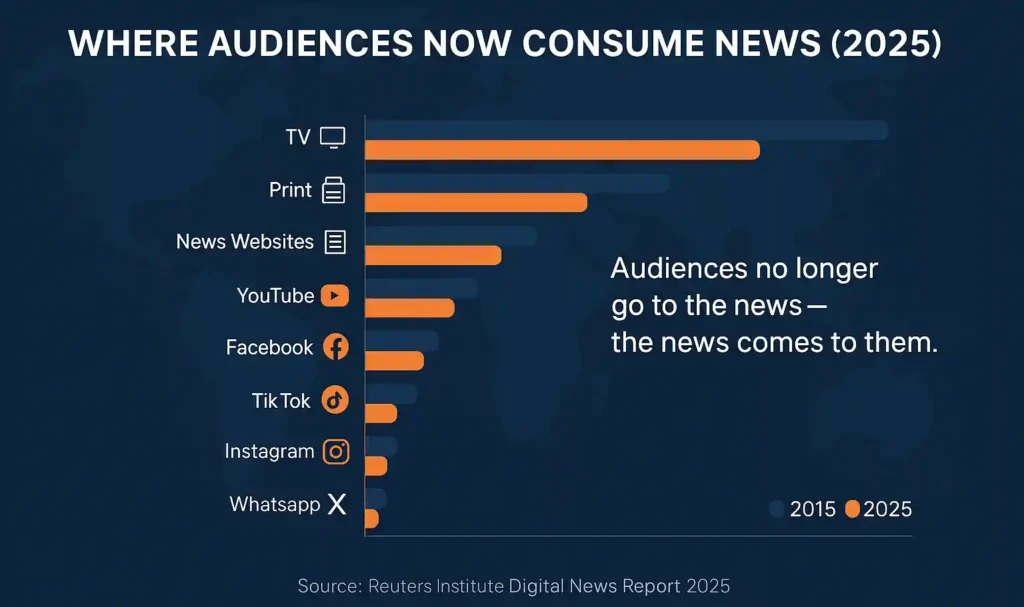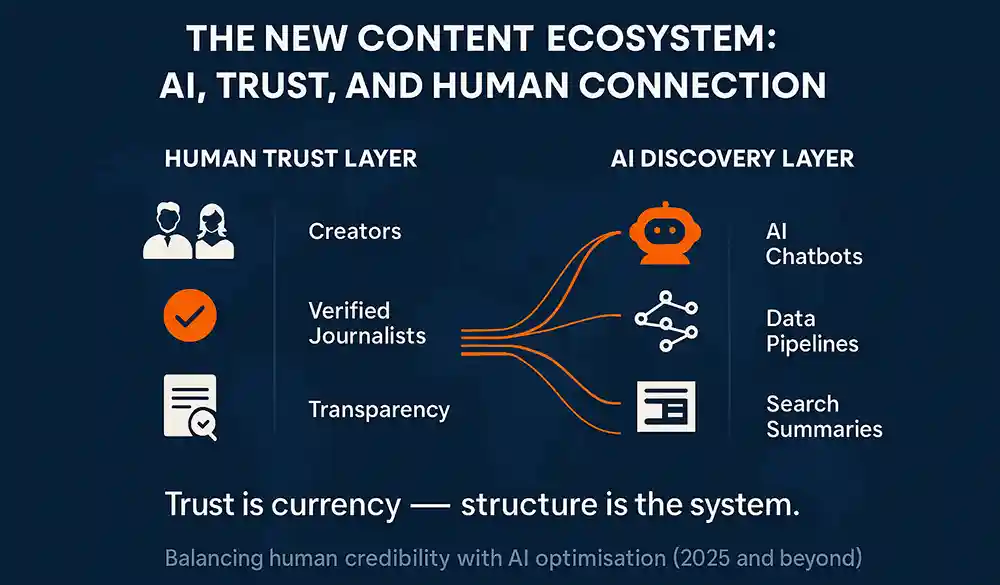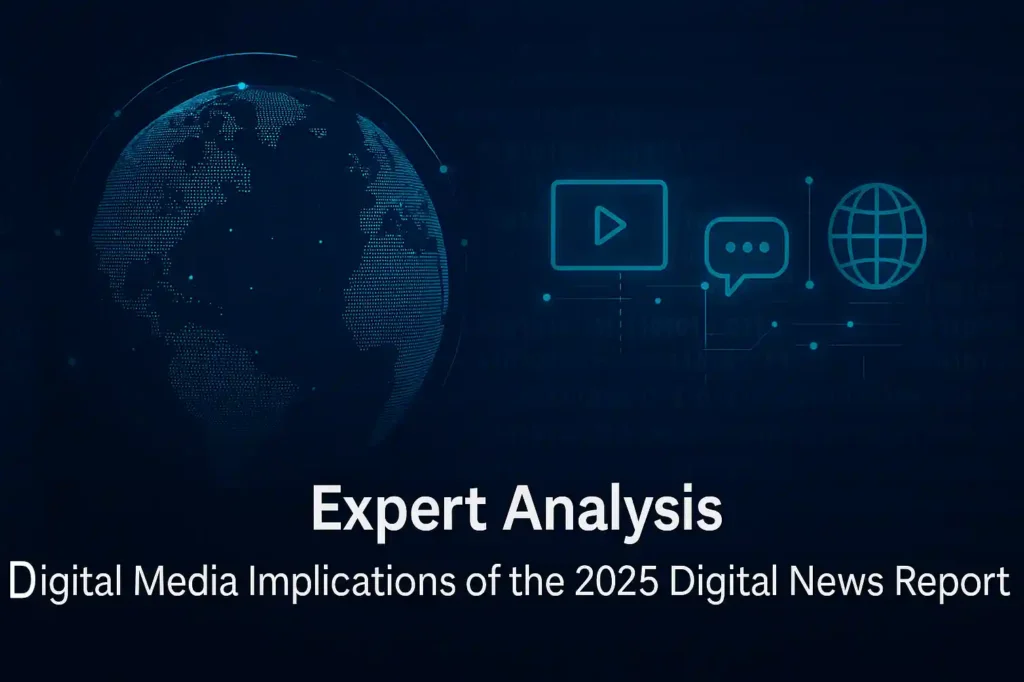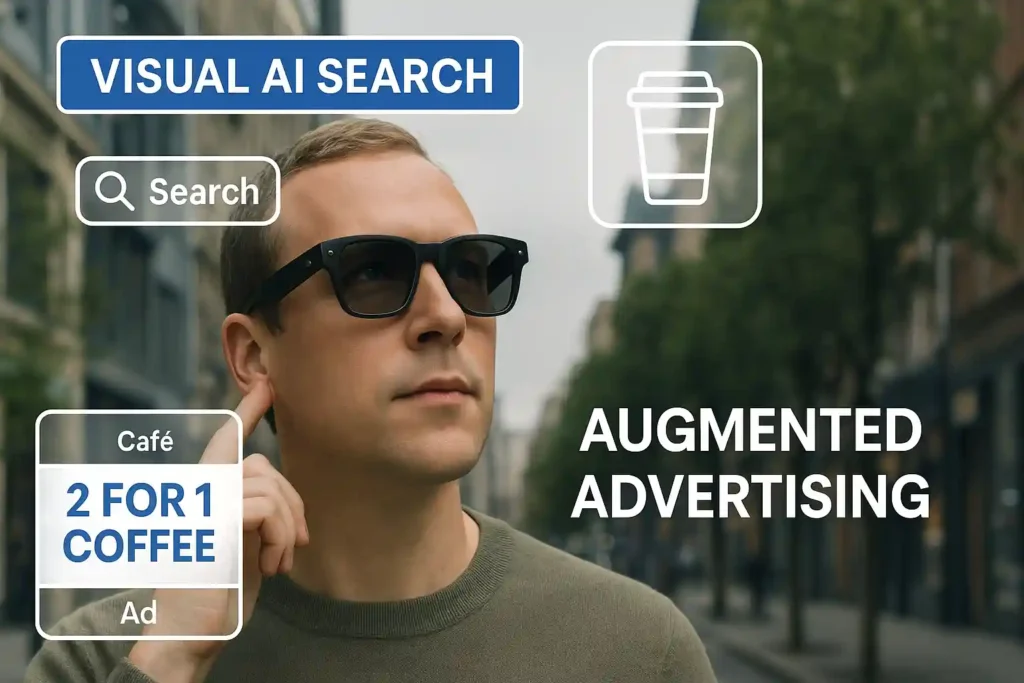Audiences aren’t “going to the news” anymore. The news now arrives in their feed. Personalities outrank publishers, short-form video outruns articles, and AI summaries sit between stories and searchers. In this attention economy, trust is earned in public, not on a homepage.
Drawing on the 2025 Digital News Report by the Reuters Institute, which covers 48 markets, this analysis translates the findings into practical steps for brands, SMEs, and agencies. If you lead marketing in Bournemouth, Poole, Dorset or anywhere in the UK, the implications are immediate: how you create, structure and distribute content now matters as much as what you say.
What you’ll get here:
- How to pivot to platform-native, personality-led video without losing rigour.
- How to build trust signals that travel: authorship, sourcing, and entity-level credibility aligned with modern SEO.
- How to prepare content for AI-mediated discovery (summaries, schema, conversational intent) and fold it into your social media marketing mix.
The goal: a news-savvy content strategy that performs in feeds, in AI search, and on your site, and does it with measurable commercial impact.
1. Traditional News Media is Flatlining — and the Audience Has Moved
Key finding: Engagement with TV, print and news websites continues to fall, while social and video platforms dominate daily information habits.
What it means: People, especially under-40s, now discover news through feeds, creators and short-form video instead of visiting homepages or news apps.
It’s no secret that TV, print and even big news websites are losing ground. The audience hasn’t just drifted — it’s moved. Under-40s rarely visit homepages anymore. They don’t open news apps. They discover what’s happening through feeds, creators and short-form video.
For businesses, that shift matters more than you might think. Because if attention has moved, then so has trust. The people your brand wants to reach now decide what’s credible based on who they follow, not which publication reports it.
That’s what I call the distributed trust model: people trust people, not platforms.
So if you’re still relying on press mentions or company updates buried in your blog, you’re playing yesterday’s game. What works now is human-first communication:
- Put a real person, a face, a voice, at the centre of your content.
- Tell stories that connect, not announcements that vanish.
- Use video and social media dialogue to direct people to your website, rather than waiting for them to discover it.
Strategic takeaway:
Your website remains your foundation, but it’s no longer the primary entry point. Credibility now begins in the feed, where people see, hear, and decide whether they believe you.
2. Influencer-led News is the New Normal
Key finding: One-fifth of US audiences consumed news from Joe Rogan in the week after the inauguration; in France, 22 % of under-35s followed Hugo Travers on YouTube and TikTok.
What it means: The authority once held by traditional journalism has shifted to individual creators who build trust through direct engagement.
The way people consume “news” has completely changed, and it’s not coming from the traditional press anymore. One in five Americans got updates from Joe Rogan last year. In France, nearly a quarter of under-35s turn to Hugo Travers on YouTube and TikTok. Across Asia, similar patterns play out daily.
What that tells us is simple: the gatekeepers have gone. The news and its audience now reside within creator ecosystems.
For businesses and agencies, that’s a significant mindset shift. You’re no longer competing for coverage in established outlets; you’re competing for trust and time inside audiences built by individuals.
Innovative brands have already caught on. They’re moving part of their PR and communication budgets away from press releases and into long-term partnerships with creators who actually shape the conversation. The power dynamic has flipped.
The new rule of visibility is algorithmic credibility; it’s not about who’s “official”, it’s about who shows up consistently, with relevance and personality.
Strategic takeaway:
Every business is now in the same arena as creators. If you want visibility, stop treating influencers as an optional add-on and start seeing them as modern media partners — collaborators who can amplify your story far beyond your own reach.
3. Platform Fragmentation Demands Multi-Format Storytelling
Key finding: Six major online networks now reach more than 10% of global audiences for news, up from just two a decade ago. Facebook and YouTube lead, but TikTok, Instagram, WhatsApp, and X are rapidly shaping how people discover and discuss information. According to the DataReportal Global Digital Overview 2025, social media use now accounts for more than 40 % of total online time, underscoring how platform fragmentation has permanently changed discovery habits.
What it means: There’s no single “main channel” anymore. Audiences are split across multiple platforms, each with its own culture, algorithms, and storytelling style, meaning the old one-size-fits-all content model no longer works.
Back in the day, a single campaign could run everywhere with one creative set. Not anymore. The landscape is fractured, and attention is scattered across feeds that all behave differently.
For business owners and agencies, this fragmentation isn’t a headache; it’s a chance to reach audiences in more meaningful ways. But it requires adapting your story for each environment rather than reposting the same message everywhere. This is precisely where effective social media marketing plays a crucial role, understanding not just where your audience is active, but how to shape content that fits the native tone and rhythm of each platform.
That’s where multi-format storytelling comes in, saying one thing well, but in multiple, platform-native ways:
- Short, vertical video for TikTok or Reels that hooks instantly.
- Longer, educational explainers for YouTube.
- Conversation-led posts for LinkedIn and X that spark dialogue.
- Quick, story-driven snippets for WhatsApp groups or private communities.
Each platform has its own rhythm, tone, and expectation. The key is context – the right story, in the right place, at the right time.
Strategic takeaway:
The strongest brands are fluent across formats. They don’t duplicate; they translate. If your campaign still starts with “What do we post?”, shift the question to “Where does this story live best, and how will people experience it there?”

4. Video Dominance and the Rise of Personality-Led Formats
Key finding: Across all markets, social video consumption has grown from 52% in 2020 to 65% in 2025, while overall video use has risen to 75%. In several countries, including the Philippines, Thailand, Kenya and India, more people now prefer watching news than reading it.
What it means: Video is no longer an optional marketing channel; it’s how people consume information. The audience now expects news, insights and brand stories to be delivered through movement, voice and personality, not paragraphs.
Video has quietly become the default language of digital communication. Research from the Ofcom Media Nations 2025 Report shows that UK adults now spend over two-thirds of their online time watching video, confirming this shift from reading to viewing. Whether it’s a journalist, influencer, or brand expert, the people leading attention online are doing it on camera, not in text.
For agencies and businesses, this shift cuts both ways. It’s a challenge if you’re used to written content, but it’s a massive opportunity if you’re willing to humanise your brand. A consistent presence through personality-led video builds familiarity, trust, and shareability far faster than static posts ever could.
If you’re a small business or an SME, don’t think in terms of high-budget production. Think in terms of visibility with substance. A short, honest clip explaining a customer story, showing your process, or discussing a trending topic can outperform any press mention or brochure download.
For agencies, this is now a core skillset. Helping clients turn expertise into natural, on-camera communication is as vital as ad buying or SEO.
Strategic takeaway:
Video isn’t just part of your marketing mix; it is the mix. The brands winning attention today are led by visible people with consistent voices. If your audience never sees or hears from a real person behind your business, someone else’s video is already taking their attention.
5. X (Twitter) Has Polarised but Stabilised
Key finding: The use of X for news has grown across several markets, increasing by 8 percentage points in the US, 6 percentage points in Australia, and 6 percentage points in Poland. Since Elon Musk’s takeover in 2022, the platform has attracted more right-leaning users, particularly younger men, while many progressive audiences have reduced their activity or left entirely.
What it means: X remains influential but has become a more polarised environment. It still matters for professional visibility and real-time conversation, but brands must now navigate tone and community with far more care than before.
Despite predictions of its demise, X remains a unique presence in the media ecosystem. It’s fast, public and searchable, qualities that still make it valuable for business communication, thought leadership and news reaction. But the tone of conversation has shifted. Audiences on X are more divided, debates are more heated, and engagement often rewards strong opinions over balanced insight.
For business owners and SMEs, that means it’s no longer the place for generic promotional posts or corporate voice. Instead, X works best when used for authentic expertise and conversation, commenting on trends, sharing original insight, or responding quickly to relevant topics. The brands that do well sound human, not rehearsed.
For agencies, X remains a vital listening tool. It’s where you can still track live sentiment, competitor behaviour, and emerging narratives before they surface elsewhere. But participation should be strategic — deliberate, not reactive.
Strategic takeaway:
X hasn’t lost relevance; it’s just changed character. Treat it as a conversation channel, not a broadcast one. Show thought, not polish. If your brand contributes meaningfully to the discussion, you’ll still build credibility, even in a noisier, more polarised space.
6. Podcasting’s Hybrid Evolution
Key finding: The report shows that 15% of US audiences now listen to one or more news podcasts each week, with many of these also being filmed and shared as video versions on YouTube and TikTok. In contrast, many Northern European markets are still dominated by traditional audio formats from legacy media outlets.
What it means: Podcasting has evolved from an audio niche into a video-driven, multi-platform ecosystem. It’s no longer just about listening; audiences now watch podcasts, interact with clips, and share moments across social channels.
Podcasting has matured into something far more dynamic than its early days. What began as long-form, on-demand audio has merged with the world of short-form video, creator culture, and platform-native storytelling. Today, a “podcast” might just as easily be a filmed studio chat or a two-minute vertical clip on TikTok.
For businesses and agencies, this shift is gold. It opens up an affordable and credible route to build authority and reach new audiences without incurring heavy ad spend. Whether you’re a marketing agency in Bournemouth or an SME in Poole, podcasts offer a powerful blend of visibility, education, and trust-building. You don’t need a full studio setup; what matters is insight and personality.
The best-performing podcasts aren’t always polished; they’re authentic, regular, and audience-aware. Each episode becomes a hub of content that can be sliced into microclips for social media, transcribed for SEO, and repurposed for newsletters or LinkedIn thought leadership.
Strategic takeaway:
Podcasting is no longer just an audio format; it’s a content engine. Treat every recording as multi-channel fuel: one conversation can feed your YouTube, TikTok, LinkedIn, and blog presence simultaneously. Brands that master this loop will own both the ear and the algorithm.
7. The TikTok–Trust Paradox
Key finding: TikTok is the fastest-growing platform for news, adding four percentage points across markets and reaching 49% of online audiences in Thailand and 40% in Malaysia. Yet, in those same regions, it’s also viewed as one of the most significant sources of false or misleading information, alongside Facebook.
What it means: TikTok offers a massive reach, especially among younger audiences, but it comes with a built-in credibility issue. The very features that make it addictive, speed, remix culture, and algorithmic personalisation, also make it easy for misinformation to spread.
TikTok has revolutionised the way people consume stories. Its short-form, fast-moving nature rewards emotion, humour, and creativity, not necessarily accuracy. For brands, this creates both an opening and a trap. The platform’s visibility potential is enormous, but audiences are increasingly sceptical about what they see.
For business owners and SMEs, the challenge is learning to harness TikTok without losing trust. That means showing up with authenticity and substance, rather than chasing trends. Behind-the-scenes clips, quick tips, or educational explainers that tie back to verifiable expertise are most effective.
For agencies, TikTok now demands the same ethical rigour as journalism once did. Every claim, stat, and statement must be defensible. Pair this with consistent cross-platform validation — use your website, LinkedIn, or YouTube to anchor deeper context and transparency.
Strategic takeaway:
TikTok is no longer just entertainment; it’s a platform for information, influence, and occasionally misinformation. The brands that win here combine creativity with credibility. Treat TikTok as a discovery gateway but always connect viewers back to trusted, verifiable sources you control.
8. Rising Misinformation and Declining Trust
Key finding: 58% of global respondents say they struggle to tell what’s true or false online, the same as last year. Concern is highest in the US and Africa (73%), while Western Europe has a lower rate at 46%. Across all regions, online influencers and politicians are viewed as the top sources of misinformation (both at 47%).
What it means: The digital landscape has become a trust minefield. Audiences are overloaded, sceptical, and often unsure who or what to believe, yet they still crave clarity and credibility. This creates an environment where trust itself becomes a competitive advantage.
We’ve reached a point where misinformation isn’t an occasional problem; it’s the background noise of the internet. Every business, from global brands to local SMEs, now operates in an environment where audience trust is fragile by default.
For agencies and business owners, this means the way you communicate matters just as much as what you sell. Transparency, evidence, and visible expertise aren’t optional — they’re non-negotiable if you want to cut through the noise. The Edelman Trust Barometer 2025 reinforces this point, showing that businesses are now the most trusted institutions globally, provided they communicate openly and substantiate their claims with data.
Practical steps include:
- Visible authorship: attach names, roles, and credentials to your content.
- Source transparency: reference data, partners, and reputable sources (like this report).
- Fact-linked SEO: use schema and structured data so AI platforms can correctly identify and cite your content.
- Audience education: use your channels to explain how you verify or validate claims; that’s a subtle yet powerful trust builder.
For agencies, this is also where strategy shifts from “reach” to reputation architecture, designing systems that make your content verifiable, human, and credible across every touchpoint.
Strategic takeaway:
Trust isn’t a byproduct of communication; it’s the product itself. The brands that show how they think, not just what they sell, will become the trusted anchors in an increasingly uncertain digital world.

9. AI Enters the News Supply Chain
Key finding: Seven percent of global audiences already use AI chatbots or assistants to access news each week, rising to 15% among under-25s. At the same time, most people remain sceptical about AI-generated news, expecting it to produce content more cheaply and quickly, but less transparent and less trustworthy.
What it means: AI is now part of how information travels. Search, summarisation, and discovery are increasingly handled by generative platforms, meaning your content may be read, rewritten, or referenced by an AI long before a human ever clicks on your site.
This is the quiet revolution most brands haven’t fully clocked yet. Generative AI platforms like ChatGPT, Gemini, and Perplexity are quickly becoming the new middle layer between users and publishers. Industry analysis from the Nieman Lab 2025 Predictions suggests AI summarisation could soon overtake search snippets as a primary discovery route for news and branded content alike. That means your content isn’t just competing for attention on Google, it’s competing for interpretation inside AI systems.
For business owners and agencies, this changes the rules of visibility. The new question isn’t “How do I rank on page one?” It’s “How do I get cited, surfaced and summarised correctly by AI?”
That’s where AI-optimised content architecture comes in:
- Utilise structured data and schema markup to ensure AI systems accurately understand and credit your content.
- Write in clear, fact-based language; AI models prefer definable statements over marketing fluff.
- Maintain “human in the loop” editorial processes; audiences trust verified human authorship more than algorithmic content.
- Track how your content appears in AI-generated summaries; this will become the new standard for SEO audits.
For agencies, this is where the disciplines of SEO, brand authority, and ethical AI governance converge. AI will reward transparent expertise; the more precise your data and authorship signals, the more likely you’ll be recognised as a trusted source.
Strategic takeaway:
Generative AI isn’t the end of traditional search; it’s the next layer of it. To stay visible, brands must build content that machines can interpret, humans can trust, and algorithms can’t misrepresent. Visibility in 2025 and beyond will belong to those who optimise for both people and AI.
10. Subscription Stagnation and the Attention Economy
Key finding: The proportion of people paying for online news has flatlined at 18% across 20 developed countries. Norway (42%) and Sweden (31%) lead the way, while the US sits at 20% and many Southern and Eastern European markets are below 10%.
What it means: The paid content model has reached its ceiling. Consumers are overwhelmed by subscriptions and increasingly selective about what they’ll pay for, especially when free alternatives, summaries, and AI-assisted news are just a click away.
The modern attention economy has shifted again. People still value quality information, but they don’t want to be burdened with endless monthly commitments. For most audiences, it’s not that content has lost value; it’s that attention has become the true currency.
For publishers, media brands and even agencies offering premium insights, the challenge is finding new ways to monetise engagement. Instead of rigid subscriptions, audiences are showing more interest in flexible access models, micro-payments, bundled content, or membership-style communities that deliver value beyond a paywall.
For businesses and SMEs, the lesson is equally relevant. Don’t assume loyalty; earn it through consistent, high-quality engagement. Whether it’s newsletters, webinars, or exclusive reports, audiences will only commit time or money if your content delivers real insight and connection.
For agencies, this marks a shift from “reach metrics” to “relationship metrics”, how long people stay, how often they return, and how deeply they trust your expertise.
Strategic takeaway:
We’ve entered the era of attention economics. Stop chasing subscriptions; start building sustained attention. The brands that win are those that blend access, relevance and trust, turning fleeting interest into ongoing engagement, one interaction at a time.
Agency Recommendations for 2025–2026
| Objective | Strategic Action | Rationale |
| Rebuild trust signals | Implement E-E-A-T structured data, transparent authorship, fact-checked content | Aligns with user concern about misinformation and AI accuracy |
| Humanise communication | Introduce authentic spokesperson or creator partnerships | Audiences engage more with people than institutions |
| Adopt platform-native storytelling | Create short-form video ecosystems per platform (TikTok, YT Shorts, Reels) | Attention has moved from articles to video experiences |
| Optimise for AI discovery | Structure pages for AI summaries, schema.org markup, and conversational queries | Future traffic will route through LLM search layers |
| Leverage podcast-video formats | Blend expert audio with visual talk segments for authority building | Retains engagement and multiplies distribution |
| Data-driven content bundling | Offer modular content packages or micro-subscriptions | Consumers resist one-size paywalls |
The Digital Hype Perspective
The 2025 Digital News Report doesn’t just describe a shift in media behaviour, it confirms a complete reset in how trust, attention and influence now work. Audiences no longer “go online for news.” They live inside a constant stream of content where every scroll is a decision about who to trust, who to ignore, and who feels relevant.
From Bournemouth to Berlin, Poole to New York, the story is the same: credibility now travels through people, not platforms. The power once held by institutions has fragmented across creators, communities and algorithms. And for brands, that’s not a threat, it’s an opening.
The businesses winning right now are the ones that act like modern media brands. They understand that their content doesn’t compete with competitors; it competes with everything else in the feed. They build visibility through human storytelling, they earn trust through transparency, and they future-proof their strategy through data structure and AI-ready optimisation.
For agencies, the task ahead is straightforward. Integrate platform intelligence—design for AI discovery. Build communication systems around real people with authentic voices. Because the future isn’t just multi-channel, it’s multi-format, multi-trust and multi-reality.
At Digital Hype, that’s precisely how we’re helping brands stay visible and credible in a world where attention never stands still.
Ready to Future-Proof Your Brand’s Digital Strategy?
Audiences are moving faster than ever — across platforms, feeds, and AI-driven search. At Digital Hype, we help businesses turn these shifts into growth opportunities through human-first storytelling, AI-optimised content, and intelligent social campaigns.
Let’s Start a Conversation

